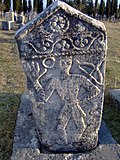Residential complex on Džidžikovac
43°51′41.0″N 18°24′56.5″E / 43.861389°N 18.415694°E / 43.861389; 18.415694
 }
}Residential complex on Džidžikovac (Cyrillic: Џиџиковац), is an architectural residential ensemble in a neighborhood of Džidžikovac in Sarajevo, Bosnia and Herzegovina, which is designated a National Monument of Bosnia and Herzegovina since 2008.[1]
History
The central area of the neighbourhood was designed and developed after the World War II, mostly between 1946 and 1959, while streets and areas in immediate surroundings were already developed and had many luxurious villas and buildings constructed during second half of the 19th century, in numerous styles of the era under the architect from around Austro-Hungarian Empire. Neighborhood is conceived as residential, on a steep hillside above city center with much greenery, never developed before, where, beside many small private flower gardens, also existed numerous plum, apple, cherry and pear orchard – hence the name Džidžikovac, which comes from the word "džidži" which is Bosnian pronunciation of Ottoman Turkish word "güzel", and which in Bosnian means: nadžidžan, nagizdan, gizdav, ukrašen, in English: picturesque, ornate or florid.[2]
After the World War II, the government's main, if not only, concern in war-torned country was to provide the people with basic housings, despite the great scarcity in terms of money and material, so an architecture, in a creative sense, was relegated to the background.
The Projektantski zavod NR BiH (transl. Design Institute of the Peoples Republic of Bosnia and Herzegovina) was main bureau in the design and construction of buildings in Sarajevo, whose leading architects were brothers, Muhamed and Reuf Kadić. The Kadić brothers were employed by Projektantski zavod in 1946, so their first major project resulting in notable designer performance was the Residential Complex in Džidžikovac, designed in 1947.[3][1]
As the informal pre-war members of the modern movement, brothers Kadić continued to exert their influence with projects and realizations, and successfully promoted the idea of moderna's functionalism and minimalism, that form should follow function, to the regime whose urgent needs were shaped by economical and other practical constraints of post-war socialist society, with the economic moment being a decisive in the design.[4] In this way, Kadić's succeeded in achieving valuable results in architecture, and the Residential complex in Džidžikovac was one such ecxample.
Location
The complex of residential buildings designated as a National Monument is located in the Džidžikovac neighborhood, in central part of Sarajevo, Municipality Center. The complex is bounded by Džikovac Street from the southeast, by Hadži-Idrizova Street from the north, by Mehmed-beg kapetana Ljubušak Street from the south and towards the west, the complex is limited by another block of residential buildings.[1]
Features

As in many other cases around central parts of Sarajevo, neighborhood designers utilized the presence of abundant natural greenery on the location and developed designated space while preserving as much as possible. This became a characteristic of the neighborhood, one which constitutes important quality and attraction.
National monument
In 2008 Džidžikovc was proclaimed National Monument of Bosnia and Herzegovina as "Residential complex on Džidžikovac – the architectural ensemble" by the Commission to preserve national monuments of Bosnia and Herzegovina, due to its architectural and landscaping qualities.[1]
See also
References
- ^ a b c d Decision: Graditeljska cjelina – Stambeni kompleks na Džidžikovcu (4 February 2008). "Commission to preserve national monuments". old.kons.gov.ba (in Bosnian). Commission to preserve national monuments. Retrieved 24 March 2017.
- ^ Sanja Šabanadžović (9 June 2015). "FOTO: Znate li priču o Džidžikovcu?". Radio Sarajevo (in Bosnian). radiosarajevo.ba. Retrieved 22 March 2017.
- ^ Džemal Čelić at al (1988). "Chapter: Braća Kadići – pioniri savremene arhitekture u BiH". Graditelji Sarajeva (full script version unavailable). Sarajevo: Skripta - Biblioteka Arhitektonski fakultet. p. 483. Retrieved 5 June 2023.
- ^ Štraus, Ivan (1977). Nova bosanskohercegovačka arhitektura 1945-1975. Sarajevo: "Svjetlost", OOUR Izdavačka djelatnost. p. 9. Retrieved 5 June 2023.
External links
 Media related to Residential complex on Džidžikovac at Wikimedia Commons
Media related to Residential complex on Džidžikovac at Wikimedia Commons
- v
- t
- e
For official site names and detailed information, see each article or the List of National Monuments of Bosnia and Herzegovina.
| Buildings |
|
|---|---|
| Bunkers & underground structures | |
| Bridges |
|
| Clock-towers |
|
| Fountains |

castles,walled cities,
open & market towns
| Royal court | |
|---|---|
| Open & market towns | |
| Walled cities | |
| Castles & citadels |
|
| Odžaci (towers) |
- Vranduk
- Old Town of Mostar
- Blagaj
- Baščaršija
- Počitelj
- Džidžikovac
- Čekaluša street
- Vratnik old walled neighborhood
ensembles
/ Cultural landscape
architectural ensembles
- Old Marijin Dvor power station
- Old Hrid power station
- Small hydro power plant Bihać on Jarak in Bihać (a.k.a. Hydro power plant „Jarak“, or „Canal Una“)
- Koševo chimney
household
and places of worship
| Islamic |
|
|---|---|
| Catholic | |
| Orthodox | |
| Judaic |
|
| Bosnian Church | |
| Other (Temple of Mithras) |
| Illyrians | |
|---|---|
| Roman | |
| Early Christianity |
|
and necropolis
| Memorials |
|
|---|---|
| Cemeteries |
|
| Türbe mausoleums |
|
| Tombs, Crypts & catacombs | |
| Necropolis |
- Sarajevo Haggadah
- Zmijanje embroidery
- Mural Zuke Džumhura
Archives, museums, etc.
- 1 Shared with Croatia, Montenegro, Serbia














